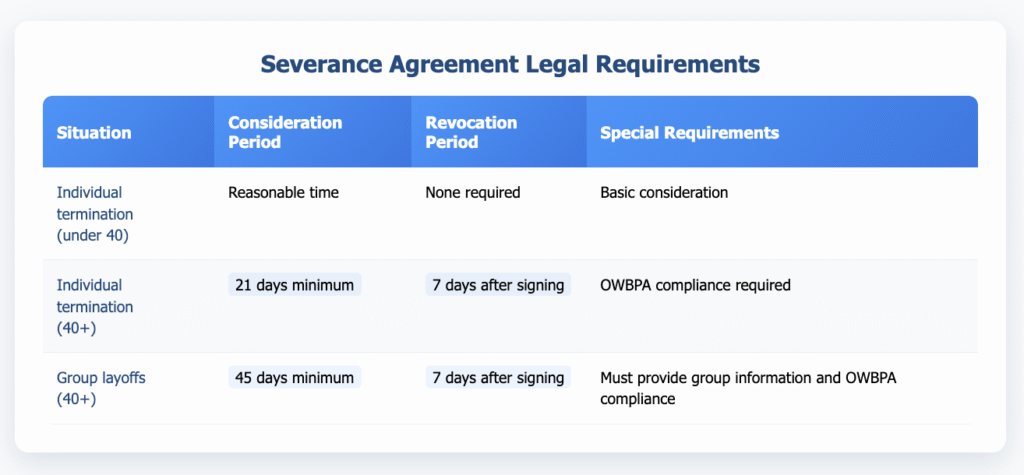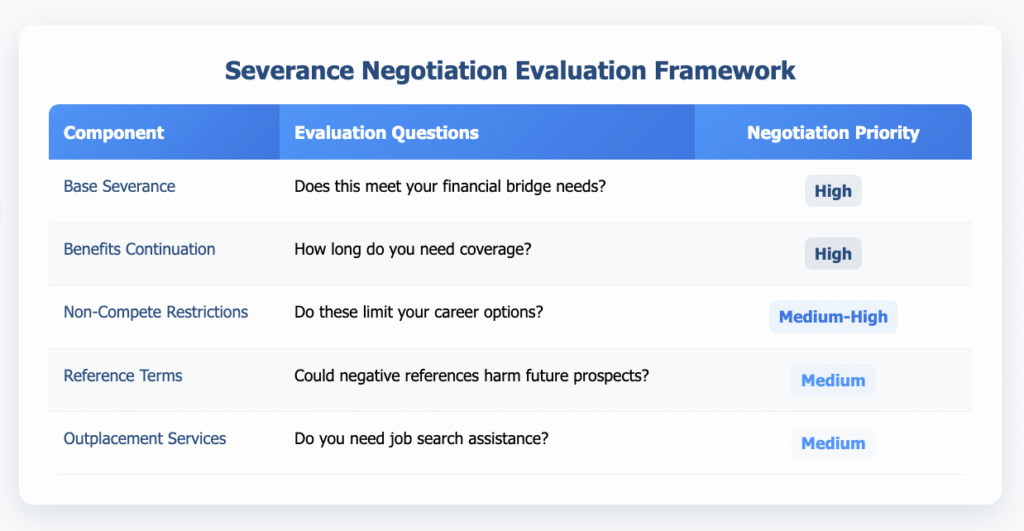When your employment ends—whether through layoffs, discrimination, or wrongful termination—you’re often presented with a severance agreement. That document sitting in front of you isn’t just a formality. It’s a negotiation opportunity that could significantly impact your financial future and legal rights.
Most employees don’t realize they have leverage in severance discussions. The truth is, employers often start with their lowest acceptable offer, expecting negotiation. Understanding what you can request, what you’re giving up, and how to approach these conversations can make the difference between a basic package and comprehensive protection for your transition.
Disclaimer: This article provides general information for informational purposes only and should not be considered a substitute for legal advice. It is essential to consult with an experienced employment lawyer at our law firm to discuss the specific facts of your case and understand your legal rights and options. This information does not create an attorney-client relationship.
Understanding Your Starting Position
Before you even look at the severance terms, you need to understand why you’re being offered a package in the first place. This context shapes your entire negotiation strategy.
If you’re facing discrimination, harassment, or wrongful termination, your severance negotiation takes on a completely different dynamic. Employers may offer enhanced packages to avoid potential legal claims. They’re not just paying for your departure—they’re potentially buying peace of mind.
If your termination followed reporting discrimination or harassment, you have additional leverage. The Older Workers Benefit Protection Act (OWBPA) provides specific protections for employees over 40, requiring 21 days to consider the agreement and 7 days to revoke after signing.
Timing and Legal Requirements

Key Components Beyond the Paycheck
Most people focus solely on the severance amount, but that’s just one piece of a comprehensive package. Here’s what smart negotiators address:
Financial Components
Your base severance payment is obviously important, but don’t stop there. Consider negotiating:
Extended benefit coverage often provides more value than additional cash. COBRA premiums can cost $600-$1,500 monthly for family coverage. Getting 6-12 months of employer-paid premiums saves substantial money.
Accrued vacation and bonus payments should be calculated carefully. If you’re entitled to a prorated bonus or have unused vacation time, ensure these amounts are clearly specified and protected.
Professional Transition Support
Outplacement services help with job searching, resume development, and interview coaching. These services typically cost $3,000-$15,000 if purchased independently.
Reference agreements matter more than many people realize. Negotiate specific language about what information will be provided to future employers. This is especially crucial if your termination involved discrimination or performance disputes.
Legal Protections and Restrictions
Understanding what legal rights you’re waiving is critical. The release of claims section determines what potential lawsuits you’re giving up in exchange for the severance payment.
Non-compete and non-solicitation clauses can severely limit your future employment options. These restrictions are often negotiable in terms of duration, geographic scope, and specific limitations.
The Negotiation Process: A Strategic Approach

Don’t rush into negotiations immediately. Take time to calculate your actual needs and research industry standards for your position level.
Strengthening Your Position
If your termination involved potential legal issues, document everything before negotiations begin. Discrimination, harassment, or retaliation claims provide significant leverage in severance discussions.
Age discrimination cases are particularly relevant for severance negotiations. If you’re over 40 and being replaced by someone significantly younger, or if age-related comments preceded your termination, this creates negotiation leverage.
Wrongful termination based on reporting harassment or discrimination often results in enhanced severance offers. Employers may prefer avoiding the cost and publicity of litigation.
Common Negotiation Wins
Based on employment law precedents and negotiation patterns, here are areas where employees often secure improvements:
Extended severance periods are frequently negotiable, especially when potential legal claims exist. Standard offers of 2-4 weeks per year of service often increase to 6-8 weeks with negotiation.
Benefit continuation extensions beyond COBRA minimums are common. Many employers will pay premiums for 6-12 months to avoid litigation risks.
Modified non-compete terms happen regularly. Geographic restrictions, duration limits, and specific industry exclusions are often negotiable.
Special Considerations for Discrimination and Harassment Cases
When your termination follows discrimination or harassment issues, severance negotiations involve additional complexity and opportunity.
Enhanced Legal Protections
The Civil Rights Act of 1991 and other employment laws provide damages remedies for discrimination that can exceed typical severance amounts. This creates leverage for enhanced packages.
Retaliation protection under various employment laws means that if your termination followed protected activities (like filing discrimination complaints), you have additional legal theories that strengthen your negotiation position.
Negotiation Strategies for Legal Claims
If you have potential discrimination or harassment claims, consider these negotiation approaches:
Address the underlying legal issues directly in severance discussions. Rather than simply accepting a standard package, acknowledge the potential claims and negotiate enhanced terms accordingly.
Include investigation closure as part of the agreement. If harassment or discrimination complaints are pending, negotiate terms that address these issues comprehensively.
What You're Actually Giving Up
The release of claims section is often the most important part of any severance agreement. Understanding what legal rights you’re waiving helps you evaluate whether the compensation is adequate.
Types of Legal Claims Typically Waived
Most severance agreements include releases for:
- Discrimination claims under federal and state law
- Harassment and hostile work environment claims
- Wrongful termination and retaliation claims
- Wage and hour violations
- Breach of contract claims
Claims That Cannot Be Waived
Certain rights cannot be legally waived in severance agreements:
- Future discrimination or harassment claims
- Unemployment compensation rights
- Workers’ compensation claims
- Rights to file charges with government agencies (though you may waive the right to monetary recovery)
Severance Negotiation Checklist
Here’s a practical checklist for your severance review and negotiation:

Red Flags in Severance Agreements
Certain terms should prompt careful review and potential legal consultation:
Overly broad release language that waives rights beyond typical employment claims may indicate the employer has concerns about broader legal exposure.
Unusual confidentiality terms that go beyond standard non-disclosure may suggest the employer is particularly concerned about certain information becoming public.
Accelerated decision timelines that pressure you to sign quickly, especially if you’re over 40, may violate legal requirements for proper consideration periods.
Making Your Decision
Your severance negotiation isn’t just about maximizing the financial package—it’s about positioning yourself for success in your next role while protecting your legal rights.
Consider both the immediate financial impact and long-term career implications. A slightly smaller severance payment with better reference terms and fewer restrictive covenants might serve you better than maximum cash with significant future limitations.
If your termination involved discrimination, harassment, or other potential legal violations, the severance negotiation becomes even more complex. The interplay between potential legal claims and severance terms requires careful analysis of your rights and leverage.
Next Steps: Getting Professional Guidance
Severance negotiations impact both your immediate financial situation and your long-term career prospects. When potential discrimination, harassment, or wrongful termination issues are involved, the stakes become even higher.
Before signing any severance agreement, especially one involving potential legal claims, consult with an experienced employment attorney. Professional guidance helps you understand your rights, evaluate the adequacy of the offer, and negotiate terms that protect your interests.
At Nisar Law Group, we help employees navigate complex severance negotiations, particularly when discrimination, harassment, or wrongful termination issues are involved. Contact us for a confidential consultation to discuss your situation and explore your options for maximizing your severance package while protecting your legal rights.


